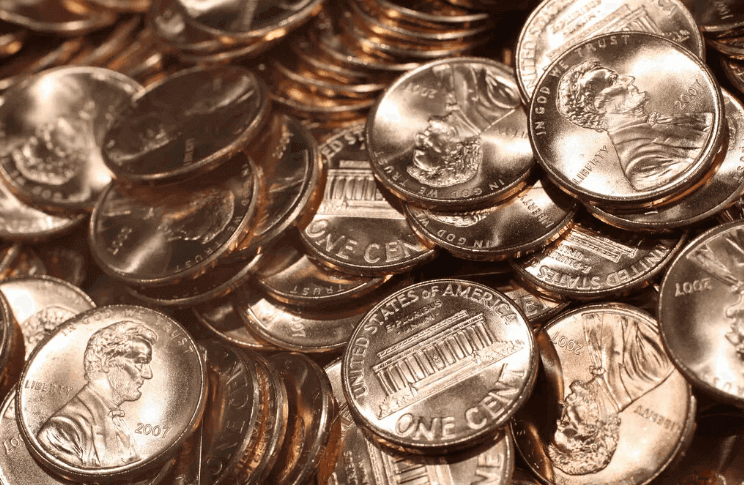【中美创新时报2025 年 2 月 10 日编译讯】(记者温友平编译)周日晚上,特朗普表示,他已下令财政部长斯科特·贝森特停止生产新版一美分硬币,此举将有助于减少不必要的政府开支。《纽约时报》记者Yan Zhuang 和 Erica L. Green对此作了下述报道。
他能做到吗?目前尚不清楚。但特朗普总统说,硬币“确实花费了我们超过 2 美分”。这是对的。
自上任以来,特朗普总统一直将目光投向格陵兰等大目标。但他也瞄准了纸吸管和硬币等小目标。
周日晚上,特朗普表示,他已下令财政部长斯科特·贝森特停止生产新版一美分硬币,此举将有助于减少不必要的政府开支。
“让我们从我们伟大国家的预算中剔除浪费,哪怕是一美分,”他在 Truth Social 的一篇文章中说道,并补充说一美分硬币“确实花费了我们超过 2 美分”。
目前尚不清楚特朗普是否有权这样做。根据美国铸币局的说法,授权制造国家硬币的是国会,而不是财政部或美联储。
但他的说法是对的,一美分硬币的价格高于其价值。多年来,专家和政府官员一直呼吁取消一美分硬币,因为尽管其生产成本上升,但其购买力却因通货膨胀而下降。
根据美国铸币局的年度报告,去年生产和发行一美分硬币的成本为 3.69 美分。这意味着,按面值计算,每枚一分硬币亏损 2.69 美分。
根据铸币厂的年度报告,去年,铸币厂发行了超过 30 亿枚一分硬币,亏损约 8530 万美元。一分硬币通常作为零钱给别人,但很少被花掉,占铸币厂当年生产的所有硬币的一半以上。去年,美国流通的一分硬币约为 2500 亿枚,约合每人 700 枚。
近几十年来,世界各国都已取消了最小面额的硬币。
2012 年,加拿大停止生产一分硬币,称其本质上是在浪费时间和空间,并认为此举每年可节省数百万美元。从那时起,在加上联邦和省级销售税后,现金交易的金额四舍五入到最接近的五分硬币。
1992 年,澳大利亚以通货膨胀和生产成本为由,停止了其一分和两分硬币的流通。更早之前,瑞典和新西兰等国家就停止铸造一分硬币。
澳大利亚国立大学应用宏观经济分析中心名誉教授安德鲁·斯托克尔表示,在澳大利亚,废除这些硬币“根本无关紧要”。他说,在美国,考虑到一分硬币的使用量很少,这一举措对经济的影响也可能微乎其微,不过政府可能会节省一些钱。
废除一分硬币的运动面临强烈反对。倡导组织“美国普通硬币联盟”认为,废除一分硬币不会省钱,因为“铸币厂的许多管理费用仍会存在,需要由其他硬币吸收,从而增加每枚硬币的成本。”
此外,该组织表示,废除一分硬币将增加对镍币的需求,而镍币的生产和分销成本更高,每枚硬币 13.78 美分。 (一角硬币是面值大于生产成本的最小硬币。)
一分硬币的支持者还认为,取消一分硬币实际上会向消费者征收一分的销售税,因为以 99 美分结尾的价格非常普遍。
但斯托克尔教授表示,大部分抵制可能与感情有关。
“人们会把它放在镇纸或类似的东西里;可能会有人囤积,”他谈到一分硬币时说。“它只是一种纪念品。没有什么意义。”
题图:数十枚便士堆叠在一起。多年来,专家和政府官员一直呼吁取消硬币。来源:Stephen Hilger/彭博新闻社
附原英文报道:
Trump Orders Treasury Secretary to Stop Minting Pennies
Can he do that? It’s not clear. But President Trump is right when he says that pennies “literally cost us more than 2 cents.”
Dozens of pennies are stacked on each other in a pile.
For years, experts and government officials have called for eliminating the penny.Credit…Stephen Hilger/Bloomberg News
By Yan Zhuang and Erica L. Green
Erica L. Green is a White House correspondent.
Published Feb. 9, 2025
Updated Feb. 10, 2025, 10:22 a.m. ET
Since taking office, President Trump has set his sights on big targets, like Greenland. But he has also taken aim at small ones, like paper straws. And pennies.
On Sunday night, Mr. Trump said he had ordered the Treasury secretary, Scott Bessent, to stop producing new pennies, a move that he said would help reduce unnecessary government spending.
“Let’s rip the waste out of our great nations budget, even if it’s a penny at a time,” he said in a post on Truth Social, adding that pennies “literally cost us more than 2 cents.”
It is unclear whether Mr. Trump has the power to do this. It is Congress, not the Treasury or the Federal Reserve, that authorizes the manufacture of the nation’s coins, according to the U.S. Mint.
But he is right that pennies cost more than they are worth. For years, experts and government officials have called for eliminating the penny, whose purchasing power has fallen because of inflation even as its production costs have risen.
It cost 3.69 cents to produce and distribute a penny last year, according to the U.S. Mint’s annual report. This means that, accounting for their face value, each penny made a loss of 2.69 cents.
Last year, the Mint issued over three billion pennies, according to its annual report, at a loss of about $85.3 million. Pennies, which are often given as change but rarely spent, accounted for more than half of all the coins the Mint produced that year. There were about 250 billion pennies in circulation, or about 700 per person, in the United States, last year.
Countries around the world have eliminated their smallest-denomination coins in recent decades.
In 2012, Canada stopped producing pennies, describing them as essentially a waste of time and space and arguing that the move would save millions of dollars a year. Since then, cash transactions have been rounded to the nearest nickel, after federal and provincial sales taxes are added.
Australia withdrew its one- and two-cent coins from circulation in 1992, citing inflation and production costs. Even earlier, countries like Sweden and New Zealand stopped minting their one-cent coins.
In Australia, the elimination of those coins “hasn’t mattered at all,” said Andrew Stoeckel, an honorary professor at the Australian National University’s Centre for Applied Macroeconomic Analysis. In the U.S., given how little pennies are used, the move would also likely have a negligible impact on the economy, though the government would probably save some money, he said.
The movement to eliminate pennies has faced significant opposition. Americans for Common Cents, an advocacy group, has argued that eliminating pennies would not save money, because “many overhead expenses at the Mint would remain and would need to be absorbed by other coins, increasing their per-unit costs.”
In addition, the elimination of the penny will increase the demand for nickels, which are even more expensive to produce and distribute at 13.78 cents per coin, the organization said. (The dime is the smallest coin whose face value is greater than what it costs to produce.)
Penny proponents have also argued that eliminating the coin would effectively impose a one-cent sales tax on consumers, because prices ending in 99 cents are so common.
But much of the resistance may have to do with sentimentality, said Professor Stoeckel.
“People will put it in a paperweight or something; there’ll probably be some hoarding,” he said of the penny. “It’s just a memento kind of thing. There’s no significance.”
